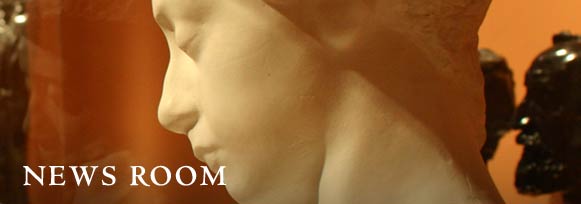Renowned Collection of Drawings by Michelangelo and Other Italian Masters on View at the Cantor Arts Center
500 Years of Italian Master Drawings from the Princeton University Art Museum
May 22–August 24, 2015
Stanford, Calif.—Nearly 100 masterworks from the 15th through the 20th centuries—accompanied by new research and fresh insights—go on view at the Cantor Arts Center May 22 in 500 Years of Italian Master Drawings from the Princeton University Art Museum. The exhibition, which is organized thematically, includes a markedly broad spectrum of works, ranging from the early Renaissance to early Modernism. As such it is a panoramic depiction of the pivotal role played by drawing, or “disegno,” in the Italian design process. In that process, drawing encompasses both the mental formulation and the physical act of creation and focuses on the human figure.
This major traveling exhibition features rarely seen highlights by such artists as Michelangelo, Barocci, Bernini, Carpaccio, Annibale Carracci, Guercino, Modigliani, Parmigianino, Giambattista and Domenico Tiepolo, Tintoretto and Veronese. Many of the drawings have benefited from new discoveries concerning attribution, iconography, date, function and provenance. Among the noteworthy findings is the discovery, first made in the 1990s, of an architectural sketch by Michelangelo on the reverse side of a study of heads that had been tentatively associated with the artist. The ground plan for an unrealized chapel was revealed through infrared reflectography.
Several of the rich moments in the exhibition derive from cross-historical pairings that show how young artists copied from the masters as a way of practicing before they drew from life. The pairings also emphasize the relationship of drawing to prints, prints being the first mass-produced images widely circulated. Further, the pairings illustrate the ill will that sometimes ensued in the “culture of copying” rife during the Renaissance.
Connie Wolf, the Cantor’s John & Jill Freidenrich Director, says, “This extraordinary exhibition underlines how important university art museums are—how deep they can go with their collections and their scholarship and how dedicated they are to sharing their resources with students, faculty, and the public across the country, if not the world. We are thrilled that our partnership with the Princeton University Art Museum will allow our visitors to see this very special exhibition.”
A fully illustrated catalogue, Italian Master Drawings from the Princeton University Art Museum, accompanies the exhibition. The catalogue is authored and edited by Laura Giles, the Heather and Paul G. Haaga, Jr. (Princeton, ’70) Curator of Prints and Drawings at the Princeton University Art Museum. Other contributors include Princeton University Lecturer in the Department of Art & Archaeology Lia Markey and independent writer and scholar Claire Van Cleave.
Exhibition Tours
Docent-led tours take place on Thursdays at 12:15 p.m., Saturdays and Sundays at 2 p.m., beginning Thursday, May 28. Meet in the main lobby.
Exhibition Organization and Support
The exhibition is organized by the Princeton University Art Museum, with major support from the Getty Foundation. Additional funds were generously provided by Diane W. Burke, and Susan and John Diekman. We gratefully acknowledge support for the exhibition from the Susan and John Diekman Director's Discretionary Fund and the Elizabeth Swindells Hulsey Exhibitions Fund.
About the Cantor Arts Center
The Cantor Arts Center at Stanford University is a vital and dynamic institution with a venerable history. Founded in 1891 with the university, the historic museum was expanded and renamed in 1999 for lead donors Iris and B. Gerald Cantor. The Cantor’s encyclopedic collection spans 5,000 years, includes more than 40,000 artworks and beckons visitors to travel around the world and through time: from Africa to the Americas to Asia, from classical to contemporary. With 24 galleries presenting selections from the collection and more than 20 special exhibitions each year, the Cantor serves Stanford’s academic community, draws art lovers from the San Francisco Bay Area and beyond and attracts campus visitors from around the world. Free admission, free tours, lectures, family activities plus changing exhibitions make the Cantor one of the most well-attended university art museums in the country and a great resource for teaching and research on campus.
# # #
Visitor Information
The Cantor Arts Center is open Wednesday–Monday, 11 a.m.–5 p.m., Thursday until 8 p.m. Admission is free. The Cantor is located on the Stanford campus, off Palm Drive at Museum Way. Parking is free after 4 p.m. weekdays and all day on weekends and major holidays. Information: 650-723-4177, museum.stanford.edu, museum.stanford.edu.
Notes to Editors
• To arrange an interview, obtain an exhibition checklist or request a copy of the catalogue, contact Anna Koster, Head of Communications, Cantor Arts Center, 650-725-4657, akoster@stanford.edu
• For high-resolution publicity images, contact PR Assistant Manager Margaret Whitehorn, Cantor Arts Center, 650-724-3600, mmwhite@stanford.edu

Gian Lorenzo Bernini (Naples, 1598–1680), Seated Male Nude, c. 1618–24. Red chalk heightened with white chalk on buff laid paper , 16-5/8 x 10-11/16 in. Princeton University Art Museum, Museum purchase, Laura P. Hall Memorial Fund and Fowler McCormick, Class of 1921, Fund

Giovanni Battista Tiepolo (Venice 1696–1770), Roman Soldier, 1720–22. Brush and red chalk wash, over black chalk, on beige laid paper, 10-3/8 x 7-1/8 in. Princeton University Art Museum, Bequest of Dan Fellows Platt, Class of 1895



